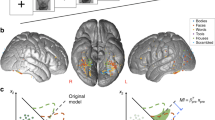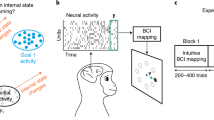Abstract
Attention is commonly thought to be manifest through local variations in neural gain. However, what would be the effects of brain-wide changes in gain? We hypothesized that global fluctuations in gain modulate the breadth of attention and the degree to which processing is focused on aspects of the environment to which one is predisposed to attend. We found that measures of pupil diameter, which are thought to track levels of locus coeruleus norepinephrine activity and neural gain, were correlated with the degree to which learning was focused on stimulus dimensions that individual human participants were more predisposed to process. In support of our interpretation of this effect in terms of global changes in gain, we found that the measured pupillary and behavioral variables were strongly correlated with global changes in the strength and clustering of functional connectivity, as brain-wide fluctuations of gain would predict.
This is a preview of subscription content, access via your institution
Access options
Subscribe to this journal
Receive 12 print issues and online access
$209.00 per year
only $17.42 per issue
Buy this article
- Purchase on Springer Link
- Instant access to full article PDF
Prices may be subject to local taxes which are calculated during checkout








Similar content being viewed by others
References
Felder, R.M. & Silverman, L.K. Learning and teaching styles in engineering education. Eng. Educ. 78, 674–681 (1988).
Coffield, F., Moseley, D., Hall, E. & Ecclestone, K. Learning Styles and Pedagogy in Post-16 Learning: a Systematic and Critical Review (Learning and Skills Research Centre, London, 2004).
Felder, R.M. & Spurlin, J. Application, reliability and validity of the index of learning styles. Int. J. Eng. Educ. 21, 103–112 (2005).
Servan-Schreiber, D., Printz, H. & Cohen, J.D. A network model of catecholamine effects: gain, signal-to-noise ratio, and behavior. Science 249, 892–895 (1990).
Aston-Jones, G. & Cohen, J.D. An integrative theory of locus coeruleus–norepinephrine function: adaptive gain and optimal performance. Annu. Rev. Neurosci. 28, 403–450 (2005).
Gilzenrat, M.S., Nieuwenhuis, S., Jepma, M. & Cohen, J.D. Pupil diameter tracks changes in control state predicted by the adaptive gain theory of locus coeruleus function. Cogn. Affect. Behav. Neurosci. 10, 252–269 (2010).
Jepma, M. & Nieuwenhuis, S. Pupil diameter predicts changes in the exploration-exploitation trade-off: evidence for the adaptive gain theory. J. Cogn. Neurosci. 23, 1587–1596 (2011).
Waterhouse, B.D., Moises, H.C. & Woodward, D.J. Noradrenergic modulation of somatosensory cortical neuronal responses to lontophoretically applied putative neurotransmitters. Exp. Neurol. 69, 30–49 (1980).
Waterhouse, B.D., Moises, H.C., Yeh, H.H., Geller, H.M. & Woodward, D.J. Comparison of norepinephrine- and benzodiazepine-induced augmentation of Purkinje cell responses to gamma-aminobutyric acid (GABA). J. Pharmacol. Exp. Ther. 228, 257–267 (1984).
Waterhouse, B.D. & Woodward, D.J. Interaction of norepinephrine with cerebrocortical activity evoked by stimulation of somatosensory afferent pathways in the rat. Exp. Neurol. 67, 11–34 (1980).
Koss, M.C. Pupillary dilation as an index of central nervous system α2-adrenoceptor activation. J. Pharmacol. Methods 15, 1–19 (1986).
Einhäuser, W., Stout, J., Koch, C. & Carter, O.L. Pupil dilation reflects perceptual selection and predicts subsequent stability in perceptual rivalry. Proc. Natl. Acad. Sci. USA 105, 1704–1709 (2008).
Murphy, P.R., Robertson, I.H., Balsters, J.H. & O'Connell, R.G. Pupillometry and P3 index the locus coeruleus-noradrenergic arousal function in humans. Psychophysiology 48, 1532–1543 (2011).
Salinas, E. Fast remapping of sensory stimuli onto motor actions on the basis of contextual modulation. J. Neurosci. 24, 1113–1118 (2004).
Salinas, E. & Bentley, N.M. Gain modulation as a mechanism for switching reference frames, tasks and targets. Coherent Behav. Neuronal Netw. 3, 121–142 (2009).
Haider, B. & McCormick, D.A. Rapid neocortical dynamics: cellular and network mechanisms. Neuron 62, 171–189 (2009).
Eguíluz, V.M., Chialvo, D.R., Cecchi, G.A., Baliki, M. & Apkarian, A.V. Scale-free brain functional networks. Phys. Rev. Lett. 94, 018102 (2005).
Luce, R.D. & Perry, A. A method of matrix analysis of group structure. Psychometrika 14, 95–116 (1949).
Easterbrook, J.A. The effect of emotion on cue utilization and the organization of behavior. Psychol. Rev. 66, 183–201 (1959).
Staal, M.A. Stress, Cognition, and Human Performance: a Literature Review and Conceptual Framework (NASA STI Program, 2004).
Dias-Ferreira, E. et al. Chronic stress causes frontostriatal reorganization and affects decision-making. Science 325, 621–625 (2009).
Schwabe, L. & Wolf, O.T. Stress-induced modulation of instrumental behavior: from goal-directed to habitual control of action. Behav. Brain Res. 219, 321–328 (2011).
Schwabe, L., Tegenthoff, M., Höffken, O. & Wolf, O.T. Concurrent glucocorticoid and noradrenergic activity shifts instrumental behavior from goal-directed to habitual control. J. Neurosci. 30, 8190–8196 (2010).
Schwabe, L., Höffken, O., Tegenthoff, M. & Wolf, O.T. Preventing the stress-induced shift from goal-directed to habit action with a β-adrenergic antagonist. J. Neurosci. 31, 17317–17325 (2011).
Alexander, J.K., Hillier, A., Smith, R., Tivarus, M. & Beversdorf, D. Beta-adrenergic modulation of cognitive flexibility during stress. J. Cogn. Neurosci. 19, 468–478 (2007).
Campbell, H.L., Tivarus, M.E., Hillier, A. & Beversdorf, D.Q. Increased task difficulty results in greater impact of noradrenergic modulation of cognitive flexibility. Pharmacol. Biochem. Behav. 88, 222–229 (2008).
Maier, A. et al. Divergence of fMRI and neural signals in V1 during perceptual suppression in the awake monkey. Nat. Neurosci. 11, 1193–1200 (2008).
Sirotin, Y.B. & Das, A. Anticipatory haemodynamic signals in sensory cortex not predicted by local neuronal activity. Nature 457, 475–479 (2009).
Logothetis, N.K. What we can do and what we cannot do with fMRI. Nature 453, 869–878 (2008).
Dayan, P. & Yu, A.J. Norepinephrine and neural interrupts. in Advances in Neural Information Processing Systems 18 (eds. Weiss, Y., Schölkopf, B. & Platt, J.) 243–250 (MIT Press, Cambridge, Massachusetts, 2006).
Bullmore, E. & Sporns, O. Complex brain networks: graph theoretical analysis of structural and functional systems. Nat. Rev. Neurosci. 10, 186–198 (2009).
Bullmore, E. & Sporns, O. The economy of brain network organization. Nat. Rev. Neurosci. 13, 336–349 (2012).
Bassett, D.S. et al. Dynamic reconfiguration of human brain networks during learning. Proc. Natl. Acad. Sci. USA 108, 7641–7646 (2011).
Kitzbichler, M.G., Henson, R.N., Smith, M.L., Nathan, P.J. & Bullmore, E.T. Cognitive effort drives workspace configuration of human brain functional networks. J. Neurosci. 31, 8259–8270 (2011).
Nicol, R.M. et al. Fast reconfiguration of high-frequency brain networks in response to surprising changes in auditory input. J. Neurophysiol. 107, 1421–1430 (2012).
Reas, C. & Fry, B. Processing: a Programming Handbook for Visual Designers and Artists (MIT Press, Cambridge, Massachusetts, 2007).
McClelland, J.L. & Rumelhart, D.E. Explorations in Parallel Distributed Processing: A Handbook of Models, Programs and Exercises (MIT Press, Cambridge, Massachusetts, USA, 1988).
Lambert, A., Wells, I. & Kean, M. Do isoluminant color changes capture attention? Percept. Psychophys. 65, 495–507 (2003).
Brainard, D.H. The psychophysics toolbox. Spat. Vis. 10, 433–436 (1997).
Hoeks, B. & Levelt, W.J.M. Pupillary dilation as a measure of attention: a quantitative system analysis. Behav. Res. Methods Instrum. Comput. 25, 16–26 (1993).
Fisher, R.A. On the “probable error” of a coefficient of correlation deduced from a small sample. Metron 1, 3–32 (1921).
Acknowledgements
We thank N. Turk-Browne and P. Dayan for helpful comments on earlier versions of the manuscript. This research was funded by US National Institutes of Health grants R03 DA029073 and R01 MH098861, a Howard Hughes Medical Institute International Student Research fellowship to E.E. and a Sloan Research Fellowship to Y.N. The authors also wish to thank the generous support of the Regina and John Scully Center for the Neuroscience of Mind and Behavior in the Princeton Neuroscience Institute.
Author information
Authors and Affiliations
Contributions
E.E. and Y.N. designed the study with consultation from J.D.C. E.E. and Y.N. analyzed the data, and all of the authors contributed to discussion and interpretation of the findings and writing the manuscript.
Corresponding author
Ethics declarations
Competing interests
The authors declare no competing financial interests.
Supplementary information
Supplementary Text and Figures
Supplementary Figures 1–7 and Supplementary Table 1 (PDF 2798 kb)
Rights and permissions
About this article
Cite this article
Eldar, E., Cohen, J. & Niv, Y. The effects of neural gain on attention and learning. Nat Neurosci 16, 1146–1153 (2013). https://doi.org/10.1038/nn.3428
Received:
Accepted:
Published:
Issue Date:
DOI: https://doi.org/10.1038/nn.3428
This article is cited by
-
Changes in pupil size track self-control failure
Experimental Brain Research (2024)
-
Dynamic Organization of Large-scale Functional Brain Networks Supports Interactions Between Emotion and Executive Control
Neuroscience Bulletin (2024)
-
Adaptive control of synaptic plasticity integrates micro- and macroscopic network function
Neuropsychopharmacology (2023)
-
Nonequilibrium thermodynamics of the asymmetric Sherrington-Kirkpatrick model
Nature Communications (2023)
-
Acceleration of inferred neural responses to oddball targets in an individual with bilateral amygdala lesion compared to healthy controls
Scientific Reports (2023)



